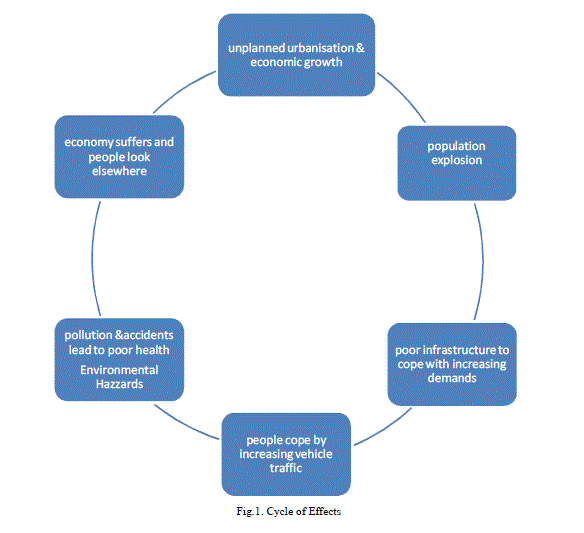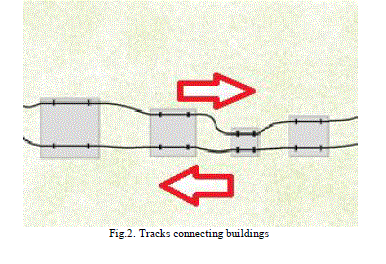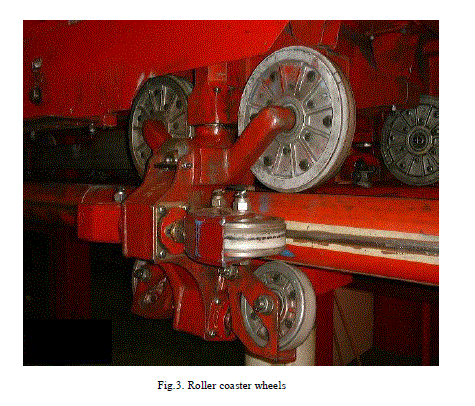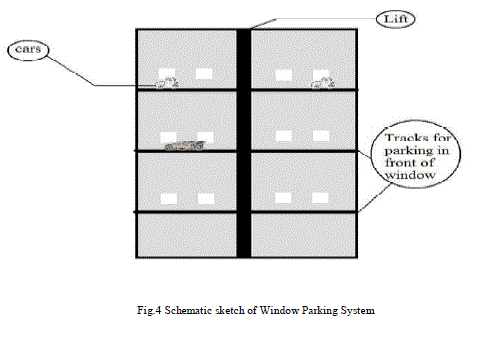ISSN ONLINE(2319-8753)PRINT(2347-6710)
ISSN ONLINE(2319-8753)PRINT(2347-6710)
Akash Yadav1, Nikhil Sahu1, Utsav Agrawal1 and Natwar Lal2
|
| Related article at Pubmed, Scholar Google |
Visit for more related articles at International Journal of Innovative Research in Science, Engineering and Technology
This presentation discusses to consider the transportation facilities of the rapidly growing population in future. It aims at investigating an efficient transport system and strategies to implement it. The upgraded transport system would be:  A safer and comfortable  Fuel effective  Non hazardous to the environment i.e. minimum emission.  An automated one.  Fast and cost effective.
Keywords |
| Sustainable transport; Roof to roof transportation; window parking system |
INTRODUCTION |
| The varied urban, rural and coastal nature of the landscape has a significant influence on transport provision and accessibility. This in turn has major implications for people’s quality of life and ranks highly amongst the concerns of residents and businesses. For example, it has major effects on health, air quality and how we meet our everyday needs. Car ownership and traffic levels have increased over recent years, whilst the use of public transport has declined. In both urban and rural areas, lack of access to a car, walking/cycling opportunities or good quality public transport, contributes to social exclusion - in particular affecting our ability to move around and access health, education, employment, recreational facilities and public services. Smart Transport is the modernization of present road and railways network. It would enable a safer and less cumbersome and fuel-effective mode of transport. It should also increase the transportation capacity of the city |
II. DRAWBACKS OF EXISTING SYSTEM |
| Current evaluation methods tend to under value mobility management (also called Transportation Demand Management or TDM) strategies that increase transport system efficiency by changing travel behaviour, due to biases that include: • Ignore mobility management or only considers a few strategies. Emission reduction planning sometimes ignores mobility management altogether, or only considers a limited number of potential strategies. • Ignore co-benefits. Current analysis gives little consideration to benefits such as congestion reduction; road and parking facility cost savings, consumer savings, reduced traffic accidents, and improved mobility for non-drivers, although these benefits are often larger in total value than emission reduction benefits. • Ignore induced travel impacts. Current analysis generally ignores the additional external costs that result when increased vehicle fuel efficiency and subsidized alternative fuels stimulates additional vehicle travel, called a rebound effect. • Considers mobility management emission reductions difficult to predict. Although case studies and models exist for many of these strategies, this information is not widely applied to energy planning. • Considers mobility management programs difficult to implement. Such programs often involve multiple stakeholders, such as regional and local governments, employers and developers, and various special interest groups. As a result, they tend to seem difficult and risky compared with other emission reduction strategies that only require changes to utility operations, fuel production or vehicle designs. • Assumes vehicle travel reductions harm consumers and the economy. In fact, many mobility management strategies benefit consumers directly and increase economic productivity. There is plenty of evidence that, with improved travel options and efficient incentives, consumers would choose to drive less, rely more on alternative modes, and be better off overall as a result. More comprehensive and objective analysis tends to rank mobility management strategies among the most costeffective emission reduction options. |
III. EFFECTS |
| A. Pollution • Some 210 tons per day of total pollution is produced in the city. Around 65% of the pollution is due to vehicles. PM10 (also referred to as respiratory suspended particulate matter, RSPM) are significant in causing medical problems (asthma and lung cancers). • But pollution of air is not the only problem we need to worry about. The average noise level at posh road is approximately around 95 decibels. This is much higher than the permitted level of 65 decibels. At peak (rush hours) the levels are known to rise up to 125 decibels. Sustained noise at this level can lead to deafness. But subtle effects of a combination of the noise and air pollution include irritability, fatigue, anger and their consequences. B. Accidents & deaths But there are bigger costs of the above state of affairs. Accidents and deaths are a common place in Indian cities. Unlike cities in the West, pedestrians, bicyclists and Motorized Two Wheelers constitute 75% of the total fatalities in road traffic crashes. C. Fuel Consumption & Comfort Mileage reduction strategies tend to be ignored because people often assume they are difficult to implement and harm consumers. That is not necessarily true. Many motorists would prefer to drive somewhat less and rely more on alternative modes, provided those alternatives are convenient, comfortable and affordable. Improving travel options and rewarding mileage reductions can benefit consumers directly, as well as reduce emissions and other transport problems. D. Parking Lack of space for parking results in congested and crowded vehicle stands which later causes traffic jams and damage to vehicles. E. Traffic Congestion Traffic congestion occurs when a volume of traffic or modal split generates demand for space greater than the available road capacity, this is point is commonly termed saturation. There are number of specific circumstances which cause or aggravate congestion; most of them reduce the capacity of a road at a given point or over a certain length, or increase the number of vehicles required for a given volume of people or goods. Traffic jams directly relates to fuel consumption and uncomfortable transportation. |
 |
| The following terminologies should be kept in mind before designing a transportation system: ïÃâ÷ Sustainable Transportation ïÃâ÷ Intelligent Transport System A. Sustainable Transportation The term sustainable transport came into use as a logical follow-on from sustainable development, and is used to describe modes of transport, and systems of transport planning, which are consistent with wider concerns of sustainability. There are many definitions of the sustainable transport, and of the related terms sustainable transportation and sustainable mobility. One such definition, from the European Union Council of Ministers of Transport, defines a sustainable transportation system as one that: • Allows the basic access and development needs of individuals, companies and society to be met safely and in a manner consistent with human and ecosystem health, and promotes equity within and between successive generations. • Is Affordable, operates fairly and efficiently, offers a choice of transport mode, and supports a competitive economy, as well as balanced regional development. |
| • Limits emissions and waste within the planet’s ability to absorb them, uses renewable resources at or below their rates of generation, and uses non-renewable resources at or below the rates of development of renewable substitutes, while minimizing the impact on the use of land and the generation of noise. B. Intelligent Transport System The term intelligent transport system (ITS) refers to efforts to add information and communications technology to transport infrastructure and vehicles in an effort to manage factors that typically are at odds with each other, such as vehicles, loads, and routes to improve safety and reduce vehicle wear, transportation times, and fuel consumption. |
V. PROPOSED APPROACH |
| A. Roof to roof transportation mechanism This is based on the principle of working of roller coasters. It is completely a new methodology which will facilitate individual and public travel along the tracks as used in the roller coaster. The objective of this mechanism is to distribute the terrestrial traffic load by using sustainable and economical transport. This methodology also provides a win-win solution for parking. |
 |
| B. Basic design The roller coaster is a popular amusement ride developed for amusement parks. In essence a specialized railroad system, a roller coaster consists of a track that rises in designed patterns, sometimes with one or more inversions (such as vertical loops) that turn the rider briefly upside down. The track does not necessarily have to be a complete circuit, as shuttle roller coasters exhibit. Most roller coasters have multiple cars in which passengers sit and are restrained. Two or more cars hooked together are called a train. Some roller coasters run with single cars. C. Modifications In the proposed system tracks will be laid on the roof portions of the buildings this means it is a roof to roof transportation mechanism. The tracks will be so designed that the whole load is uniformly distributed through the bottom. The four wheelers and two wheelers should provided with special wheels which can hold the track without compromising the functioning of original wheels |
 |
VI. PARKING MANAGEMENT: WINDOW PARKING SYSTEM |
| As it is a roof to roof transportation therefore it is a major issue that where and how the vehicles will be parked? The proposed parking system consists of elevators provided along the length of the building and tracks laid along the windows. The one who has to reach final destinations will have to diverge itself from the main track and then with help of elevators and tracks, park the vehicle before the window. |
 |
VII. RESULTS |
| • This system also provides an excellent solution for the environmental pollution as it recommends the introduction of electric cars and gives emphasis to regular use of public transports. The new system clearly backwash the current mechanism as it is design for sustainable causes. • The modern transport mechanism provides a well favoured mechanism to cope up with the problem of water logging. • It is fast and cost effective. |
VIII. CONCLUSION |
| The strategies recommended in this paper are “win-win” solutions that provide multiple benefits. They are justified on economic efficiency grounds and so can provide essentially free emission reductions and a solution to traffic congestion. |
References |
|